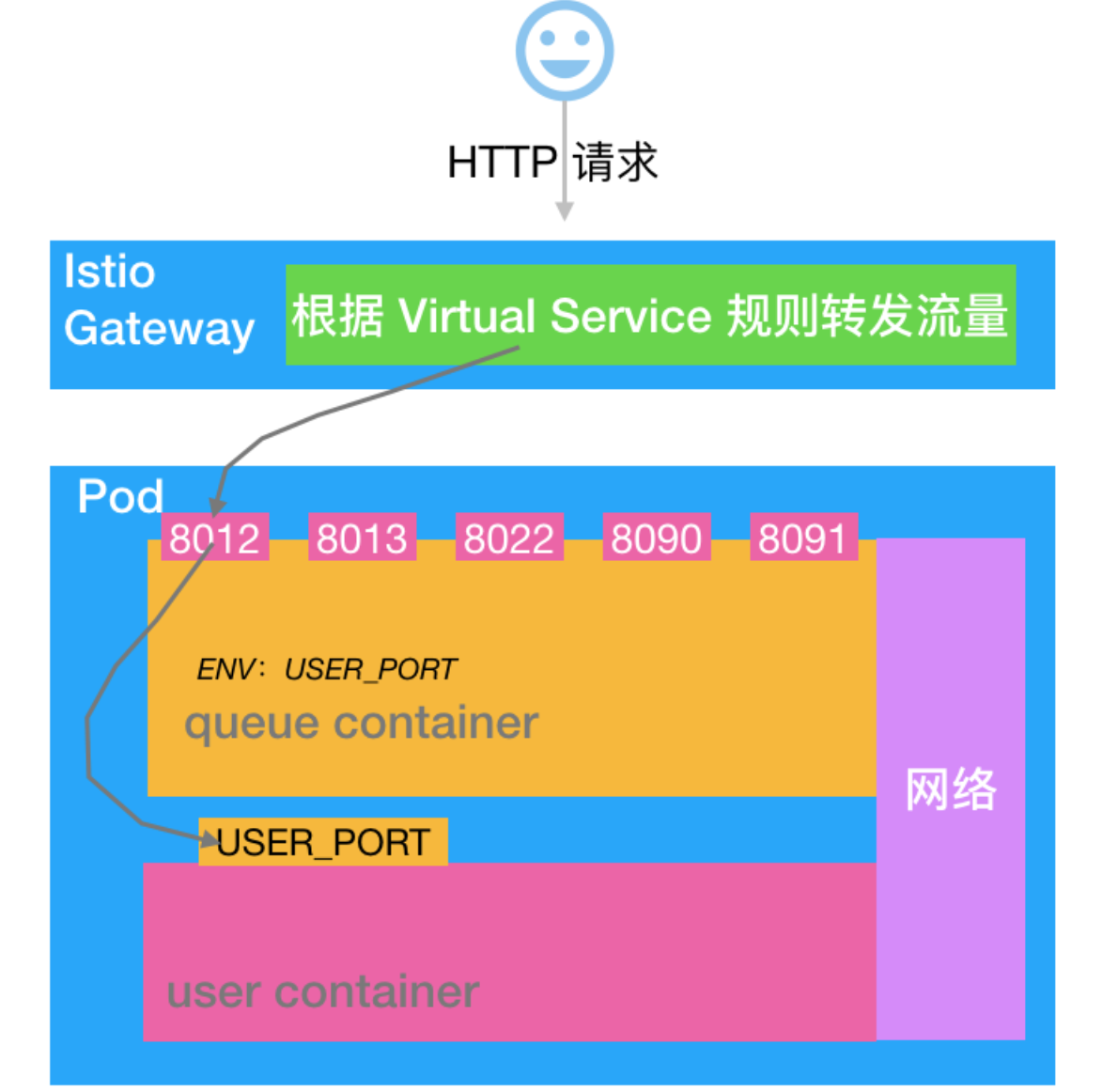Serving 健康检查机制分析
从头开发一个 Serverless 引擎并不是一件容易的事情,今天咱们就从 Knative 的健康检查说起。通过健康检查这一个点来看看 Serverless 模式和传统的模式都有哪些不同以及 Knative 针对 Serverless 场景都做了什么思考。 Knative Serving 模块的核心原理如下图所示。下图中的 Route 可以理解成是 Istio Gateway 的角色。
- 当缩容到零时进来的流量就会指到 Activator 上面
- 当 Pod 数不为零时流量就会指到对应的 Pod 上面,此时流量不经过 Activator
- 其中 Autoscaler 模块根据请求的 Metrics 信息实时动态的扩缩容

Knative 的 Pod 是由两个 Container 组成的: Queue-Proxy 和业务容器 user-container。架构如下:
 咱们以 http1 为例进行说明。业务流量首先进入 Istio Gateway,然后会转发到 Queue-Proxy 的 8012 端口,Queue-Proxy 8012 再把请求转发到 user-container 的监听端口,至此一个业务请求的服务就算完成了。
咱们以 http1 为例进行说明。业务流量首先进入 Istio Gateway,然后会转发到 Queue-Proxy 的 8012 端口,Queue-Proxy 8012 再把请求转发到 user-container 的监听端口,至此一个业务请求的服务就算完成了。
粗略的介绍原理基本就是上面这样,现在咱们对几个细节进行深入的剖析看看其内部机制:
- 为什么要引入 Queue-Proxy?
- Pod 缩容到零的时候流量会转发到 Activator 上面,那么 Activator 是怎么处理这些请求的?
- Knative 中的业务 Pod 有 Queue-Proxy 和 user-container,那么 Pod 的 readinessProber 和 LivenessProber 分别是怎么做的?Pod 的 readinessProber、 LivenessProber 和业务的健康状态是什么样的关系?
- Istio Gateway 向 Pod 转发流量的时候是怎么选择 Pod 进行转发的?
为什么要引入 Queue-Proxy
Serverless 的一个核心诉求就是把业务的复杂度下沉到基础平台,让业务代码快速的迭代并且按需使用资源。不过现在更多的还是聚焦在按需使用资源层面。 如果想要按需使用资源我们就需要收集相关的 Metrics,并根据这些 Metrics 信息来指导资源的伸缩。Knative 首先实现的就是 KPA 策略,这个策略是根据请求数来判断是否需要扩容的。所以 Knative 需要有一个机制收集业务请求数量。除了业务请求数还有如下信息也是需要统一处理:
- 访问日志的管理
- Tracing
- Pod 健康检查机制
- 需要实现 Pod 和 Activator 的交互,当 Pod 缩容到零的时候如何接收 Activator 转发过来的流量
- 其他诸如判断 Ingress 是否 Ready 的逻辑也是基于 Queue-Proxy 实现的
为了保持和业务的低耦合关系,还需要实现上述这些功能所以就引入了 Queue-Proxy 负责这些事情。这样可以在业务无感知的情况下把 Serverless 的功能实现。
从零到一的过程
当 Pod 缩容到零的时候流量会指到 Activator 上面,Activator 接收到流量以后会主动“通知”Autoscaler 做一个扩容的操作。扩容完成以后 Activator 会探测 Pod 的健康状态,需要等待第一个 Pod ready 之后才能把流量转发过来。所以这里就出现了第一个健康检查的逻辑:Activator 检查第一个 Pod 是否 ready 这个健康检查是调用的 Pod 8012 端口完成的,Activator 会发起 HTTP 的健康检查,并且设置 K-Network-Probe=queue Header,所以 Queue Container 中会根据 K-Network-Probe=queue 来判断这是来自 Activator 的检查,然后执行相应的逻辑。
参考阅读
- Activator to perform health checks before forwarding real requests https://github.com/knative/serving/issues/2856
- Activator: Retry on Get Revision error https://github.com/knative/serving/issues/1573
- Retry on Get Revision error? #1558 https://github.com/knative/serving/issues/1558
- Always pass Healthy dests to the throttler #5466 https://github.com/knative/serving/issues/5466
- Consolidate queue-proxy probe handlers #5465 https://github.com/knative/serving/issues/5465
- Queue proxy logging, metrics and end to end traces #1286 https://github.com/knative/serving/issues/1286
- End to end traces from queue proxy #3898 https://github.com/knative/serving/issues/3898
VirtualService 的健康检查
Knative Revision 部署完成以后就会自动创建一个 Ingress(以前叫做 ClusterIngress), 这个 Ingress 最终会被 Ingress Controller 解析成 Istio 的 VirtualService 配置,然后 Istio Gateway 才能把相应的流量转发给相关的 Revision。 所以每添加一个新的 Revision 都需要同步创建 Ingress 和 Istio 的 VirtualService ,而 VirtualService 是没有状态表示 Istio 的管理的 Envoy 是否配置生效的能力的。所以 Ingress Controller 需要发起一个 http 请求来监测 VirtualService 是否 ready。这个 http 的检查最终也会打到 Pod 的 8012 端口上。标识 Header 是 K-Network-Probe=probe 。Queue-Proxy 需要基于此来判断,然后执行相应的逻辑。 相关代码如下所示:
https://github.com/knative/serving/blob/master/pkg/network/probe_handler.go#L37

https://github.com/knative/serving/blob/master/pkg/reconciler/ingress/status.go#L348
 参考阅读
Gateway 通过这个健康检查来判断 Pod 是否可可以提供服务
参考阅读
Gateway 通过这个健康检查来判断 Pod 是否可可以提供服务
- New probe handling in Queue-Proxy & Activator #5159 https://github.com/knative/serving/pull/5159
- Extend VirtualService/Gateway probing to HTTPS #5156 https://github.com/knative/serving/issues/5156
- Probe Envoy pods to determine when a ClusterIngress is actually deployed #4734 https://github.com/knative/serving/pull/4734
- ClusterIngress Status https://docs.google.com/document/d/1mXDrRhVOf48qRR7-4fZMTkMHKoOGZJtrRGavGloVjGs/edit
- Consolidate queue-proxy probe handlers #5465 https://github.com/knative/serving/issues/5465
Kubelet 的健康检查
Knative 最终生成的 Pod 是需要落实到 Kubernetes 集群的,Kubernetes 中 Pod 有两个健康检查的机制 ReadinessProber 和 LivenessProber。其中 LivenessProber 是判断 Pod 是否活着,如果检查失败 Kubelet 就会尝试重启 Container,ReadinessProber 是来判断业务是否 Ready,只有业务 Ready 的情况下才会把 Pod 挂载到 Kubernetes Service 的 EndPoint 中,这样可以保证 Pod 故障时对业务无损。
那么问题来了,Knative 的 Pod 中默认会有两个 Container:Queue-Proxy 和 user-container 。前面两个健康检查机制你应该也发现了,流量的“前半路径”需要通过 Queue-Proxy 来判断是否可以转发流量到当前 Pod,而在 Kubernetes 的机制中 Pod 是否加入 Kubernetes Service EndPoint 中完全是由 ReadinessProber 的结果决定的。而这两个机制是独立的,所以我们需要有一种方案来把这两个机制协调一致。这也是 Knative 作为一个 Serverless 编排引擎是需要对流量做更精细的控制要解决的问题。所以 Knative 最终是把 user-container 的 ReadinessProber 收敛到 Queue-Proxy 中,通过 Queue-Proxy 的结果来决定 Pod 的状态。 另外 https://github.com/knative/serving/issues/2912 这个 Issue 中也提到在启动 istio 的情况下,kubelet 发起的 tcp 检查可能会被 Envoy 拦截,所以给 user-container 配置 TCP 探测器判断 user-container 是否 ready也是不准的。这也是需要把 Readiness 收敛到 Queue-Proxy 的一个动机。
Knative 收敛 user-container 健康检查能力的方法是:
- 置空 user-container 的 ReadinessProber
- 把 user-container 的 ReadinessProber 配置的 json String 配置到 Queue-Proxy 的 env 中
- Queue-Proxy 的 Readinessprober 命令里面解析 user-container 的 ReadinessProber 的 json String 然后实现健康检查逻辑。并且这个检查的机制和前面提到的 Activator 的健康检查机制合并到了一起。这样做也保证了 Activator 向 Pod 转发流量时 user-container 一定是 Ready 状态
参考阅读
- Consolidate queue-proxy probe handlers #5465 https://github.com/knative/serving/issues/5465
- Use user-defined readinessProbe in queue-proxy #4731 https://github.com/knative/serving/pull/4731
- Apply default livenessProbe and readinessProbe to the user container #4014 https://github.com/knative/serving/issues/4014
- Good gRPC deployment pods frequently fail at least one health check #3308 https://github.com/knative/serving/issues/3308
- Fix invalid helloworld example https://github.com/knative/serving/pull/4780 这里面有比较详细的方案讨论,最终社区选择的方案也是在这里介绍的
- Allow probes to run on a more granular timer. #76951 https://github.com/kubernetes/kubernetes/issues/76951
- Merge 8022/health to 8012/8013 #5524 https://github.com/knative/serving/pull/5524
- TCP probe the user-container from the queue-proxy before marking the pod ready. #2915 https://github.com/knative/serving/pull/2915
- [WIP] Use user-defined readiness probes through queue-proxy #4600 https://github.com/knative/serving/pull/4600
- queue-proxy /heatlth to perform TCP connect to user container #2912 https://github.com/knative/serving/issues/2912
使用方法 如下所示可以在 Knative Service 中定义 Readiness
apiVersion: serving.knative.dev/v1alpha1
kind: Service
metadata:
name: readiness-prober
spec:
template:
metadata:
labels:
app: helloworld-go
spec:
containers:
- image: registry.cn-hangzhou.aliyuncs.com/knative-sample/helloworld-go:160e4db7
readinessProbe:
httpGet:
path: /
initialDelaySeconds: 3
但是需要说明两点:
- 和原生的 Kubernetes Pod Readiness 配置相比,Knative 中 timeoutSeconds、failureThreshold、periodSeconds 和 successThreshold 如果要配置就要一起配置,并且不能为零,否则 Knative webhook 校验无法通过。并且如果设置了 periodSeconds 那么一旦出现一次 Success,就再也不会去探测 user-container(不建议设置 periodSeconds,应该让系统自动处理 )
- 如果 periodSeconds 没有配置那么就会使用默认的探测策略,默认配置如下
timeoutSeconds: 60
failureThreshold: 3
periodSeconds: 10
successThreshold: 1
从这个使用方式上来看其实 Knative 是在逐渐收敛 user-container 配置,因为在 Serverless 模式中需要系统自动化处理很多逻辑,这些“系统行为”就不需要麻烦用户了。
小结
前面提到的三种健康检查机制的对比关系:
| Probe Request Source | Path | Extra features | comment |
|---|---|---|---|
| Activator probe requests | :8012 | With header K-Network-Probe=queue. Expected queue as response body. |
Probe requests from Activator before it proxies external requests |
| VirtualService/Gateway probe requests | :8012 | With header K-Network-Probe=probe and non-empty K-Network-Hash header | This is used to detect which version of a VirtualService an Envoy Pod is currently serving. They are proxied from VirtualService to activator/queue-proxy. |
| Kubelet probe requests | :8012 | With non-empty K-Kubelet-Probe header or with header user-agent=kube-probe/* | I don’t think currently kubectl sends probe requests to this path. We can delete it. Correct me if I was wrong. |